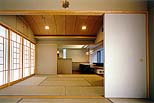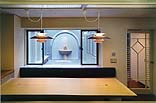|
SHIOKAWA-YA BUILDING
|
TAKEO KAMIYA, Architect




|
SHIOKAWA-YA BUILDING
|
TAKEO KAMIYA, Architect




This is a complex building for a store of household Buddhist altars and a home for its proprietor’s family at Noge-zaka, which is known as a shopping street for those kinds of goods in Yokohama. To harmonize with the well-arranged, time-honored street, it was not designed with a featureless facade but instead full of contrast and variety with eaves on top supported by braces. In contrast with the open storefront on the first floor, the second floor is covered by aluminum panels with a large symbolic half-moon shaped window. |
DATA ; Four-story steel and reinforced concrete building / Location : Noge, Naka-ku, Yokohama / Design : Takeo Kamiya architect and associates, May - November 1994 / Structural design : Haruki Ishiwa / Mechanical design : Hiroaki Higashi/ Electrical design : Shoichi Yamazaki / Furniture : Suruga isho / Construction : Nishimatus Construction, January - October 1995 / Site area : 266 square meters / Total floor area : 871 square meters / Magazine : "Kenchiku Sekkei Shiryo 84" Houses with stores / Photographs : Isao Imbe
 Drawing of Facade |
In Tokyo, along the broad street between Ueno railroad station and Asakusa are scattered abundant stores for Buddhist altar fittings, visited by a lot of customers who want to buy an altar probably only once in their lives. Its small version in Yokohama is Noge-zaka Street near the railroad station of Sakuragi-cho. This street has been enlarged into a width of 15 meters, run by sprinting cars on its steep slope, being now not necessarily considered a proper environment for choosing a Buddhist altar calmly. In spite of this, it is a tradition in Yokohama to go to Noge-zaka Street when starting to think of buying an altar or not.
The old townscape of low wooden stores has changed into that of high rise buildings, reconstructing almost all Buddhist altar stores as flat roofed square concrete buildings at Noge-zaka Street. Among them, Seki Buddhist and Shintoist Altar Store, which had been operating from the oldest times in Noge-zaka, was the last surviving wooden house. However, at its neighboring site was constructed an office building for off-track betting of horse racing, which caused differential settlement of the house, and forced the owner to finally determine to rebuild the house.
 
The requested contents for the building were two stories of store and residences for the four generations of the owner’s household, as well as a large storage for Buddhist and Shintoist altars and goods for wholesale to department stores.
 Plan of the store on the 2nd floor
The customers would not feel as if being coaxed to the 2nd floor, and also because they can view, through the void space above the gently inclining stairs, the 1st floor, mezzanine, and 2nd floor on the way. Right above the stairs is courtyard of the 3rd floor residence, the floor of which I made of glass-blocks to light the stairs and the inmost part of the 1st floor store. The back of the mezzanine has an office and a tea room for clerks, who can observe the 1st and 2nd floors through a lattice screen behind an altar and swiftly reach either floor. As the rear part of the site is low in altitude, the mezzanine corresponds to the 2nd floor of the backyard, so I arranged the grand storage all in the basement, where large altars are carried by elevator and smaller goods and fittings by a flight of stairs to the rear half down floor (actual 1st floor), which can easily get natural lighting and ventilation.
  Store on the 2nd floor Japanese style rooms
For the store to sell Buddhist and Shintoist home altars and their related goods, it is desirable to give a Japanese traditional feeling to the store’s interior design. However, I did not want to express it in raw shapes but altar it into a new design suitable for modern lives, so I put a series of 100 X 100 mm H-steel frames for the lines of altars, being continuous from the 1st to 2nd story walls to express the Japanese delicate aesthetics.
I used granite for the 1st story’s floor and travertine for the daises, on which to display altars, instead of the traditional manner of using precious timber as in Japanese taste, in order to create a new Buddhist altar store with a modern feeling by steel and stone.

As for the residences on the upper floors, the completely exclusive entrance is facing on the side street to avoid giving a bad impression to customers, which is often engendered from the invasion of household odors into the store. Since Noge-zaka street is oriented north, the openings of the residences can be placed on the rear, or sunny side, cutting off the bustle of the front road, limiting the northern openings only to the central small balconies of the living rooms, which also function as statutory emergency entrances for fire engines. Because of the few windows on the north, the main facade of the building does not give an impression of shouldering residences. On the residential floors live two households consisting of four generations: the owner’s family and a grandmother on the third floor, and his son’s family including his little children on the fourth, all of them operating the store from generation to generation. To give a certain extent of independency to the grandmother’s area, and to get ventilation and sun for each floor including the entrances and corridors, I made a small courtyard at the center of the building, expecting their outside activity there too.

 Dining room facing the patio in the 3rd floor |